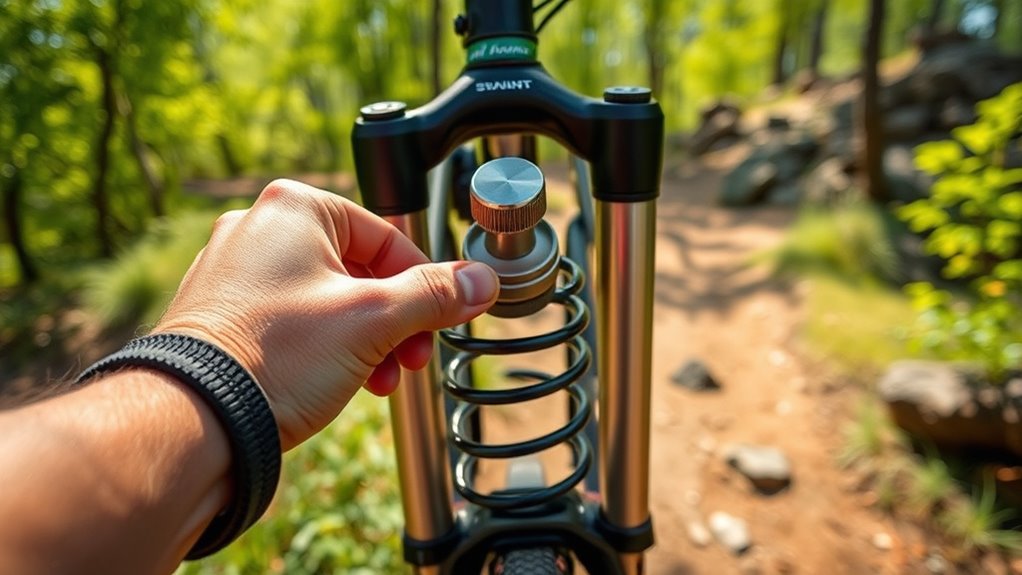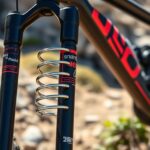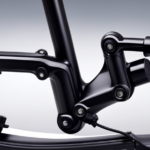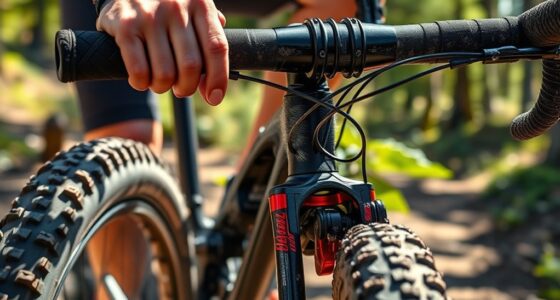To adjust your mountain bike’s suspension, start by setting the sag; measure about 15-20% of your fork’s travel and 25-30% for shocks by sitting on the bike with pressure-filled shocks. Fine-tune rebound so the suspension recovers smoothly without bouncing, and adjust compression to match terrain and riding style, using volume spacers if necessary. Regular maintenance and careful tuning help improve performance—if you want to master these adjustments, keep going for more tips.
Key Takeaways
- Measure and set proper sag (25-30% for shocks, 15-20% for forks) using an O-ring or printed measurement for optimal contact with terrain.
- Adjust rebound damping to control how quickly the suspension returns, avoiding excessive bouncing or sluggishness.
- Fine-tune compression settings and volume spacers based on terrain and riding style for a smoother, controlled ride.
- Regularly inspect and clean seals, stanchions, and dust wipers to maintain suspension performance and longevity.
- Keep a suspension log of pressure, sag, and damping adjustments, and revisit settings for different terrain conditions.
Understanding Suspension Components and Terms

To effectively adjust your mountain bike’s suspension, you need to understand its main components and key terms. Suspension components include forks at the front and shocks at the rear, both designed to absorb impacts and enhance ride comfort. The “travel” refers to the maximum distance the suspension can compress, such as 120mm or 160mm, which determines how much the suspension can absorb bumps. The “stanchion” is the shiny, movable part of the fork or shock that slides during compression. “Sag” indicates how much suspension is used when you sit on the bike, ideally 25-35% of total travel. Adjustments like rebound and compression damping control how quickly the suspension responds, ensuring a smooth, controlled ride over rough terrain. Understanding suspension tuning can help you optimize your bike’s performance for different terrains and riding styles. Additionally, familiarizing yourself with compression damping settings allows for better control over how your suspension reacts to various impacts. Properly setting preload, which adjusts the initial tension on the spring, can further fine-tune your ride based on rider weight and riding conditions. Knowing how to measure sag accurately is crucial for achieving the ideal suspension setup.
Measuring and Setting Proper Sag
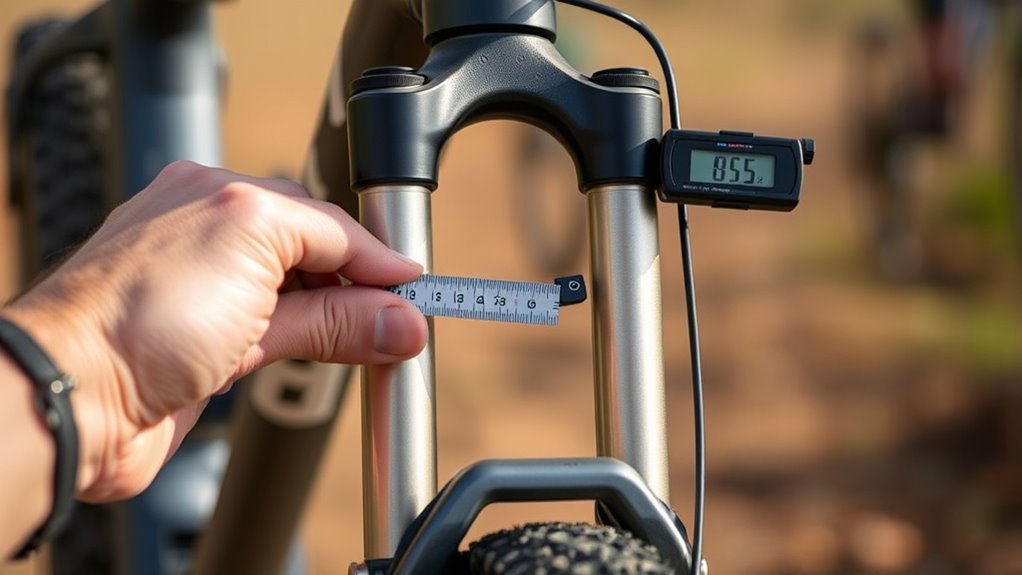
Measuring and setting proper sag guarantees your suspension works effectively over rough terrain. To do this, use the measurements printed on RockShox forks or measure the O-ring to dust wiper on other brands to determine sag. For shocks, aim for about 25-30% of total travel; for forks, 15-20%. To measure sag on air shocks, push the O-ring to the top, sit on the bike, then stand up to see where it lands, adjusting air pressure with a shock pump as needed. Coil shocks require a spring swap or preload adjustment to reach the correct sag. Keeping a suspension log of pressure, sag, rebound damping, and compression helps maintain consistent performance and simplifies future setup adjustments. Proper sag ensures maximum traction and control. Additionally, understanding industry trends can help you choose the right suspension components and settings for your riding style.
Adjusting Rebound Damping for Control
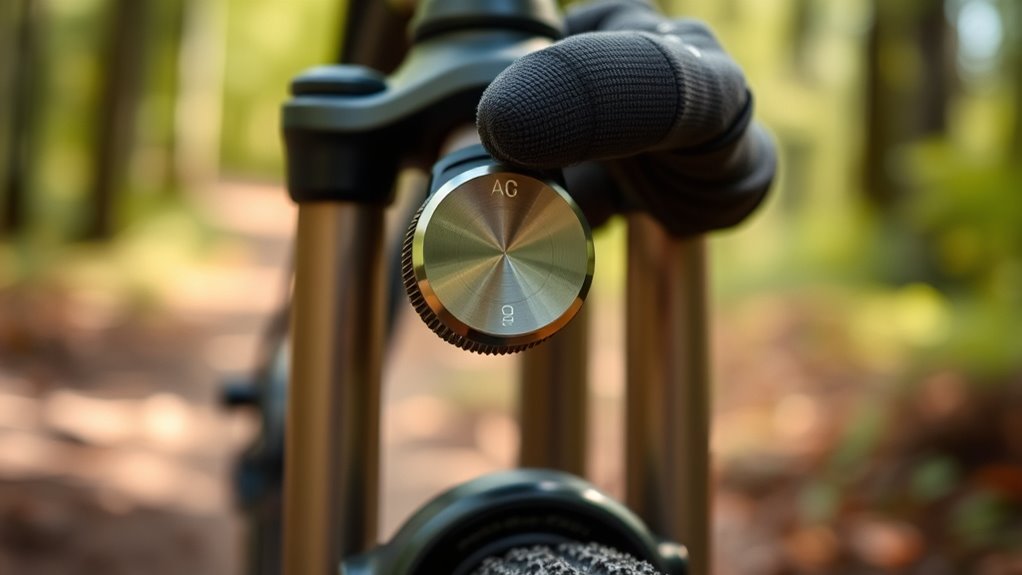
Adjusting rebound damping is essential for maintaining control and stability on rough terrain. Your suspension fork’s rebound adjustment controls how quickly it returns after compression, impacting ride smoothness. To keep in mind, setting it too fast causes bouncing, while too slow can make your ride feel sluggish. Proper rebound allows the suspension to recover swiftly without “bucking” over bumps. Always test rebound after setting correct sag, then compress the suspension to observe how it responds. Use the table below as a guide:
| Rebound Setting | Effect on Ride |
|---|---|
| Fast | Bouncing, unstable |
| Moderate | Balanced control |
| Slow | Sluggish, unresponsive |
| Too Fast | Premature rebound, loss of control |
| Too Slow | Delayed response, poor traction |
Fine-tune until the suspension feels controlled and responsive. Additionally, understanding how suspension tuning influences overall ride quality can help you make better adjustments.
Fine-Tuning Compression and Volume Spacers
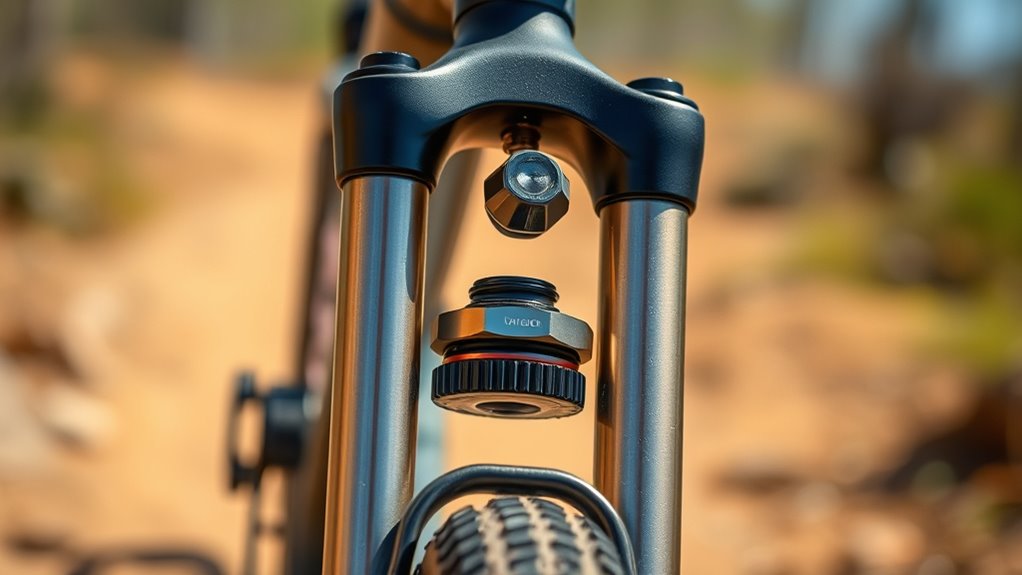
Fine-tuning your suspension’s compression settings and adding or removing volume spacers allows you to customize how your bike absorbs bumps and handles heavy impacts. Adjusting compression involves turning the blue controls for high- and low-speed damping to find the right balance between bump absorption and firmness. Adding volume spacers inside the air chamber increases suspension progression, making it more resistant to bottoming out on big hits. Removing spacers makes the suspension more linear, giving you more travel and a softer feel over small bumps. Remember, changing the number of volume spacers can affect your sag, so you may need to recheck and readjust it. Proper compression and spacer adjustments ensure your suspension responds precisely to different terrains and riding styles. Essential oils for suspension maintenance can also help in keeping your bike in top condition by reducing corrosion and ensuring smooth operation.
Maintaining and Servicing Your Suspension
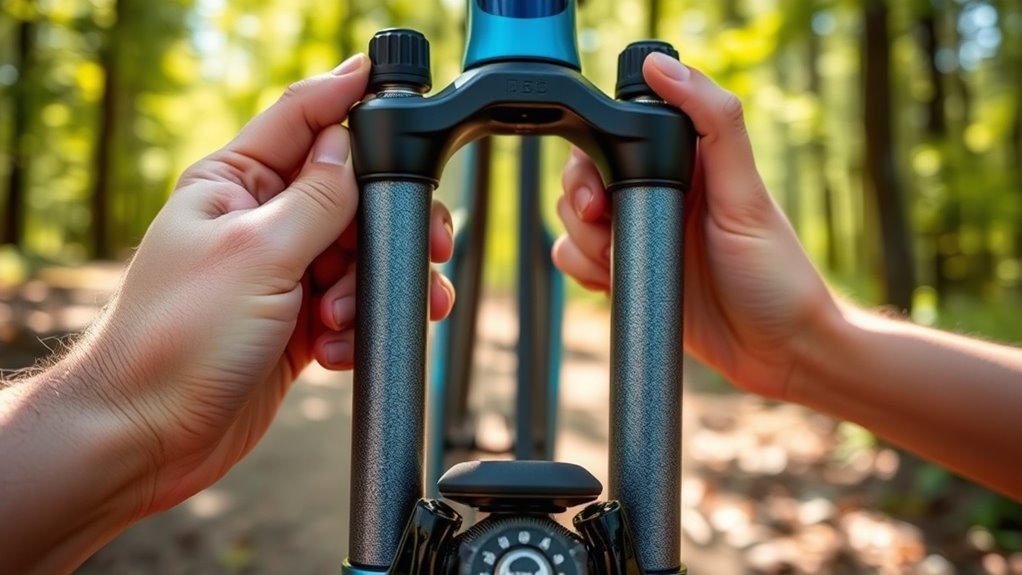
To keep your suspension performing well, you need to establish regular inspection routines and use proper cleaning techniques. Consistently check seals and stanchions for damage and clean them with a microfiber cloth to prevent dirt buildup. Staying on top of maintenance guarantees smooth operation and extends the life of your suspension components. Regularly reviewing maintenance routines can help identify potential issues early and ensure optimal performance. Additionally, monitoring air quality indicators can assist in determining when to replace filters or perform more in-depth servicing. Using appropriate filter replacement schedules ensures your suspension and air systems stay in top condition for optimal functionality. Incorporating protective styling benefits techniques can also help minimize external damage and maintain suspension integrity over time. Being mindful of cleaning and filter maintenance can further enhance the longevity and performance of your suspension system.
Regular Inspection Routines
Regular inspection of your mountain bike suspension is essential to keep it performing at its best and prevent costly damage. By regularly performing suspension inspections, you catch issues early and maintain smooth operation. Check the seals and stanchions for dirt, cracks, or leaks to avoid damage and preserve performance. Clean components with a microfiber cloth, avoiding high-pressure water that can cause water ingress and seal contamination. Schedule annual servicing for forks and shocks, especially if you ride aggressively, to replace worn oils and inspect internal parts. Additionally, periodically verify and adjust air pressure, rebound, and compression settings to match your riding conditions. Keep a maintenance log to track service dates, adjustments, and issues, ensuring your suspension stays in ideal shape. Regular inspections are especially important for vetted Halloween products to ensure safety and durability during your festivities. Regularly checking suspension components helps extend their lifespan and maintain optimal performance. Paying attention to symptoms of wear or failure can help you identify potential problems before they lead to significant damage. Incorporating routine maintenance techniques, such as inspecting internal seals and lubricating moving parts, can further enhance the longevity of your suspension. Remember that performance tuning can also improve your ride quality by fine-tuning your suspension settings to your terrain and riding style.
Proper Cleaning Techniques
Maintaining your suspension’s performance starts with proper cleaning techniques. Use a microfiber cloth to gently wipe down stanchions and suspension seals, removing dirt and grime that can cause wear. Avoid high-pressure water, as it can force dirt into seals and damage internal parts. Use a gentle, water-based cleaner for stubborn dirt, and steer clear of harsh chemicals or solvents that degrade seals and lubricants. Carefully inspect around seals and dust wipers to ensure they’re free of debris. During cleaning, press past seals with a zip-tie or shock pump end to release trapped air and prevent pressure buildup.
| Step | Action | Tips |
|---|---|---|
| 1 | Wipe with microfiber cloth | Gentle, thorough cleaning |
| 2 | Use water-based cleaner | Avoid harsh chemicals |
| 3 | Inspect seals | Check for dirt and damage |
| 4 | Press past seals | Release trapped air |
Tips for Achieving Optimal Ride Performance
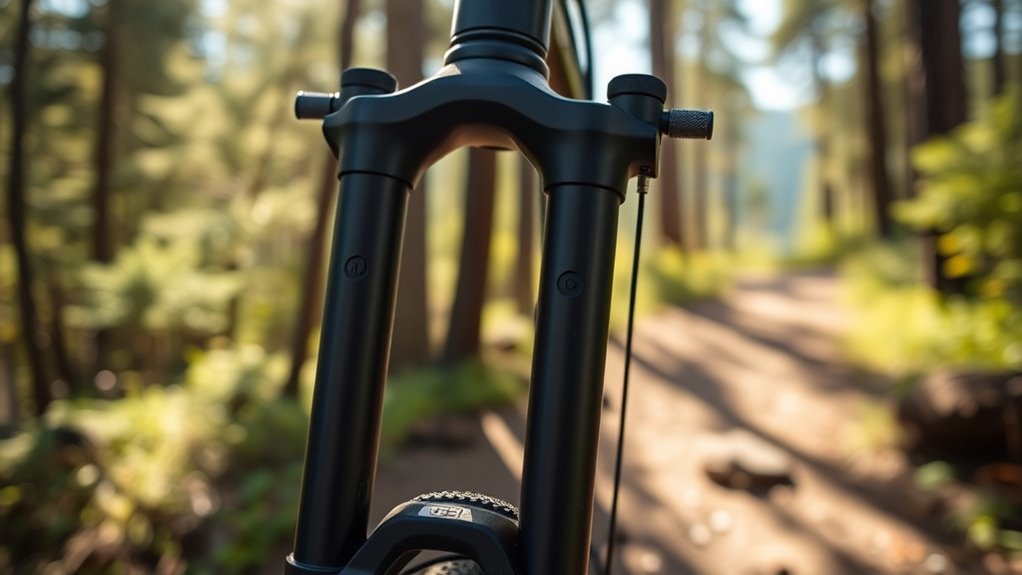
Achieving peak ride performance on your mountain bike hinges on fine-tuning your suspension settings to match your riding style and terrain. Proper suspension tuning involves adjusting sag to about 25-30% for shocks and 15-20% for forks, ensuring optimal wheel contact and control. Fine-tune rebound damping so the suspension returns quickly without bouncing—start from fully open and slow down until bounce is controlled. Adjust compression, including high- and low-speed settings, to prevent harshness and bottoming out, often by adding or removing volume spacers inside air chambers. Keeping a suspension log with pressure, rebound, and compression helps maintain consistent ride performance. Regularly revisit and tweak your settings based on terrain and riding style for better speed and control. Applying suspension settings before riding can also improve overall handling and comfort. Additionally, understanding the affairs within your riding community, such as shared tips and experiences, can provide valuable insights for improving your setup. Moreover, consulting manufacturer guidelines and product specifications can ensure your adjustments align with your specific suspension components. To achieve optimal results, consider how tuning practices can be tailored to different riding conditions and personal preferences.
Frequently Asked Questions
What Height Should My Mountain Bike Seat Be At?
You’re wondering about the right seat height for your mountain bike. To get it just right, set your saddle so your leg is almost fully extended with a slight bend at the knee when your foot’s at the bottom of the pedal stroke. Measure from the center of the bottom bracket to the top of the saddle, then adjust accordingly. This setup boosts efficiency, control, and comfort on varied terrain.
What Pressure Should My MTB Suspension Be?
Did you know that proper suspension pressure improves ride quality by up to 30%? To find yours, set your shocks to 25-30% sag and forks to 15-20%, based on your weight and riding style. Use a shock pump to add or release air, then measure sag with an O-ring or spacer. Keep adjusting until you hit the right pressure, ensuring a smooth, responsive ride every time.
Why Is My Suspension so Stiff on a MTB?
If your suspension feels stiff, it’s likely because the sag isn’t set right, or your air pressure is too high. You may also have your rebound or compression damping settings too tight, preventing smooth movement. Worn or damaged parts can cause stiffness too. Check and adjust your sag, reduce damping settings, and inspect your suspension components. Proper setup guarantees your ride is smooth and responsive.
How to Adjust Rebound on Front Forks?
To adjust rebound on your front forks, start by turning the red dial fully clockwise for the slowest setting. Then, gradually turn it counterclockwise to decrease damping until the fork responds quickly without bouncing excessively. Test by compressing the suspension firmly, ensuring it returns smoothly and promptly. Fine-tune with small adjustments, making sure rebound is slightly faster than the shock’s rebound to keep control during aggressive riding.
Conclusion
By mastering suspension adjustments, you’ll ride smoother and more confidently. Imagine hitting rough trails and feeling every bump absorbed effortlessly—like a rider who fine-tuned their shock and gained better control. Regularly check and tweak your settings, just as they did, to keep your bike performing its best. With a little practice, you’ll enjoy a more responsive, comfortable ride that’s tailored perfectly to your riding style and terrain.
